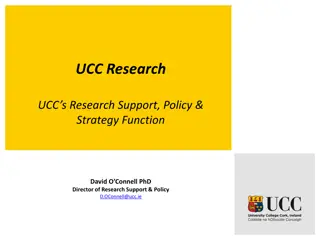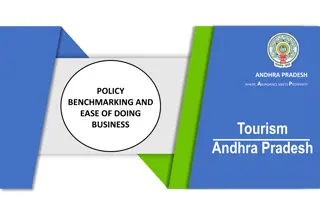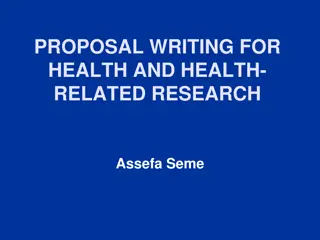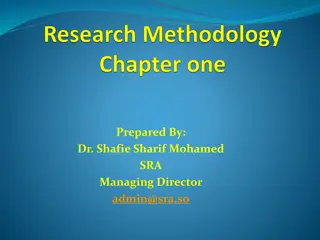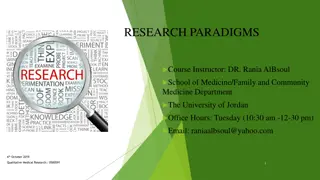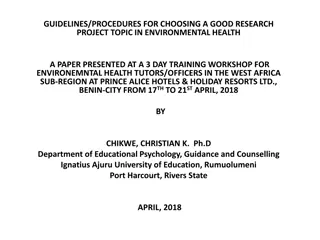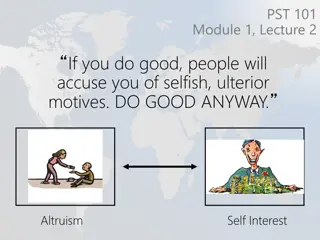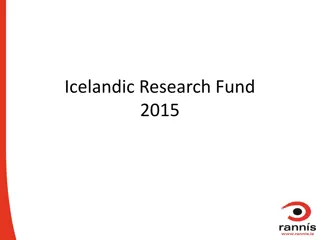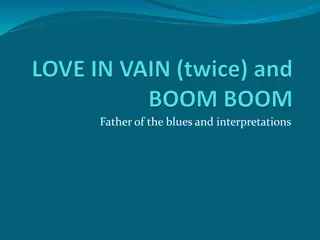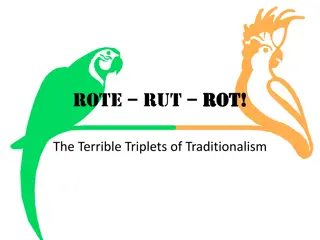Theory in Research and Practice
Exploring the relationship between theory and data, the practicality of theories, generality in abstraction, shared theories, verification in research, and the significance of theorizing in empirical domains.
Download Presentation

Please find below an Image/Link to download the presentation.
The content on the website is provided AS IS for your information and personal use only. It may not be sold, licensed, or shared on other websites without obtaining consent from the author. Download presentation by click this link. If you encounter any issues during the download, it is possible that the publisher has removed the file from their server.
E N D
Presentation Transcript
Theory-Data relationship Doing Research 2020
Theory Webster a mental viewing; contemplation a speculative idea or plan as to how something might be done a systematic statement of principles involved a formulation of apparent relationships or underlying principles of certain observed phenomena which has been verified to some degree that branch of an art or science consisting in a knowledge of its principles and methods rather than in its practice; pure, as opposed to applied, science, etc. a mere conjecture, or guess
Theory vs. Practice Theoretical is something non-practical Theory does not work in practice Kurt Lewin: There is Nothing So Practical as a Good Theory Remark: A theory cannot be applied in practice unless the subject herself understands the theory well Implication: Methods as a short cut (You Cannot Understand a System Until You Try to Change It)
Generality Something that is universally valid Generality through abstraction Induction Details -> general rules Deduction General rules -> single occurrence
Theories are shared If I can predict the occurrence of a sun eclipse and if I do not tell about it in advance, perhaps in order to bet about it, the theory is not operative (but rather pretheoretical;-)) Corollary: Theories are externalised, there is no private theory Theories should be proven: to WHOM?
Verification Key to generality Argumentation: For each .... Vulnerability Deduction Axiomatic system Axioms can be chosen and changed Rules of deduction & proof
Theory and theorizing Theory: abstract and encompassing conceptual system that claims to give an universal explanation for the phenomena within an empirical domain (high intension and extension) Newtonian physics, Evolutionary theory, Functionalist sociology, Behaviorist psychology theorizing: forming concepts and articulating their relationships to better discuss empirical phenomena studied. Guides further empirical research, conceptual work and further theorizing. Symbolic interactionism, work systems, can lead to a Theory. BUT a Theory can be a unhelpful goal due to under-determination and over- determination problems
Many types of theories The kind of theories varies The adequacy of different kinds of theory to specific topics and domains varies The make-up of how theories relate to emprical phenomena varies Different sorts of linkages to methodologies, methods, instruments
Questions in everyday language How are these things, what is their status? values or given properties / new properties Why are they as they are? Are they always in this way? Could they be in some other way? What would be needed to make them to be in this other way?
Further questions What makes these two objects appear as different? Can they be grouped into different classes? What is the purpose of such classification? Concepts as classifications What items belong to the domain of this concept? Theoretical statement is a relationship between two or more concepts (one definition)
Types of Theory Types of research rationales Doing Research 2013 sh
Types of Theory?! There are several different ways to classify different theories within philosophy of science, in Design, CHI, Soc. Sci, in Org. Sci, Most privilege one type of theory, ignorant about at least some of the theories they discuss Purpose of research, conduct of research, assumptions of reality Most classifications have highly debatable assumptions and interpretations = Beware: epistemic politics S. Gregor clarifying particularly from pp. 7 onwards (albeit with some outright mistakes and blind spots)
Types of Theories in information systems (s. Gregor), all present in Design as well (i) theory for analysing and describing, (ii) theory for understanding, (iii) theory for predicting, (iv) theory for explaining and predicting, and (v) theory for design and action.
Theory for analyzing and describing What is 1) Naming theory: naming theory is a description of the dimensions or characteristics of some phenomenon. 2) A classification theory is more elaborate in that it states that the dimensions or characteristics of a given phenomena are structurally interrelated. The dimensions may be mutually exclusive, overlapping, hierarchical, or sequential. Classification theories are frequently referred to as typologies, taxonomies or frameworks.
Theory for understanding how and why something occurred, weak prediction of future : theorizing 1a) Defamilarizing device to clear away misguided / conventional notions for improved insight 1b) Sensitizing device for more apt understanding in future work 2) Conjectures drawn from a real world situation in interpretive (case) study of how and why things happen(ed) NOTE: Always includes what , what may include elements of how and why, often disguised as classificatory principles NOTE2 Gregor 1a examples erroneous: about 1b
Theory for predicting what will be Statistical correlation theories In a strict sense very few in Design research, probably only in mechanics, but features as a component part of a theory Usual caveats of correlational and statistical analyses apply
Theory for explaining and predicting 1 what is , how , why and what will be . -- Theory with capital T. Mature theory A theory is a set of interrelated constructs (concepts), definitions, and propositions that presents a systematic view of phenomena by specifying relations among variables, with the purpose of explaining and predicting the phenomena. Few examples around design: Diffusion of Innovations Over 5000 studies Everett Rogers 1962 2003 highly contested core assumptions by now, subject to disagreement at least since 1970s Cumulation and easy accessibility the main strenght NOTE: Gregor would like to see Grounded theory (Glaser&Strauss, 1967; Clarke, 2005) leading to Theory but this far is seldom the aim.
Theory for explaining and predicting 2: Process theory Process theory Longitudinal studies with emphasis on underlying generative mechanisms explains the temporal order of events, based on a story or historical narrative. (Van de Ven, 1999; Huber, 1995) With fine line to searching for dynamics (Miettinen, 1993; Hyysalo, 2004) Historiographers & ethnographers do not see themselves as explaining but describing how, why, when and what: thick description
Theory for design and action 1. 2. 3. how to do something. Large part of Design work and publishing Engineerin type research, Prototyping approaches, Action research, participatory action research Design approaches: MUST, Idealized consumer design, contextual design Undertheorized as theories: Sensitizing fremework Approach , Recipe Methodology Require different criteria for evaluation and inference: validating a theory only its one realization with many other sources Arguing by success who measures and how or merely that it could be done! replicability often problem: repeating the device, or repeating the solution. Etc. Toothbrush syndrome :your brush is great for you to use, but not so appealing for others NOTE: often forced to play by the rules of other theories & just as often let to play without ANY rules whatsoever.
In philosophy of science Independent existence (realist) Laws of nature Wait for us to be uncovered Intolerance for inconsistence Human construct (instrumentalist) Scaffoldings Means for sense-making Partial theories in (relatively) peaceful coexistence AS A PART OF SCIENCE
Science Results produced by science Ideal results of science it may produce in the future Methods that are factually used in science Methods that ought to be used in science Community / communities formed by the scientists Institutions where science is practiced (e.g universities, research programs)
Traditional or Espoused view of Science Objectivity Rationality Criticality Intellectuality demarcate science from all else Vs. Self image, public image, rhetorical image of science. Not wholly wrong, but highly biased.
Received view of theory in analytic philosophy 1970 locial empirism positivism Observations considered neutral and certain Theories comprized of set of propositions that could be divided to observational and theoretical propositions Hypothesis deduced from theory, tested in empirical observation, theory supported or falsified by observations
Theoretical propositions Hypotheses made based on theory Observational propositions Hypotheses testing verifying or falsifying the theory Empirical reality
Vs. Received view Philosophers in their offices weak connection to scientific realities little attention to doing observation, experiments, and inferences from these 2 major problems: No theoretical proposition stands alone Theory-ladenness of observation
Underdetermination of theory by empirical evidence 1: Duhem Scientific experiment (or observation) never settles alone the faith of a hypothesis, but always together with auxiliary hypotheses About factors affecting the system studied, about test apparatuses work, and if apparatus is valid and reliable or about the relations between theory and experiment If an experiment fails some problem prevails in its relationship to theory. Often impossible to determine or test where the mismatch lies This is an accepted fact in present phil. Of science
Underdetermination of theory by empirical evidence 2: Quine Duhem + theory is not A proposition, but an integrated network of propositions that is connected to empirical realities only in its edges. It is possible to save any hypothesis--Whichever of the propositions can be held true if one is willing to make sufficiently drastic re-arrangements in the other parts of the theory-hypotheses--experiment set-ups--interpretations e.g. chrystal spheres prevailing for 100 years since Kopernicus Theoretically right, but in practice over-blown Lakatos: Hard core + protective belt : Abandoning hard core proposition is to abandon theory (ptolemaios vs. kopernicus)
Theoretical propositions Hypotheses made based on theory Observational propositions Aux hypotheses and appratuses Hypotheses testing verifying or falsifying the theory Empirical reality
Theory-ladenness of observation 1: Observation as in ability to see 1) Previous experience and practice effects the ability to make observations (skill + tuning) Expectations guide our attention and observation (not seeing the unexpected, seeing what we hope to see in a fuzzy situation) [more contested] 3) Beliefs and assumptions (physiologically) shape what we see 2)
Theory-ladenness of observation 2: observation as in getting to see 1. Theoretical assumptions guide what is selected as the research topic and site, data that gets gathered and research questions asked Observation/experiment is scientifically interesting only when it is given scientific interpretation 1. Evaluation of o/e: what is part of the system, validity of the research method, reliability of method and analysis 2. Interpretationof observations to bridge them to theory: operationalizations of theoretical terms for observables, auxiliary hypotheses (simplifications, presumptions of the parameters and their values, grain size of data chosen for analysis) etc. 2.
Theory-ladenness of observation 3: Phenomena and data Bogen & Woodward: Phenomen: steady and repeatable effect or process that allows prediction or systematic explanation by theory and can act as evidence for this theory Data: Evidence produced by measurement, by experimentation or by observation for the existence of the phenomenon or its features Theories concern/explain phenomena, not data & researchers do not examine data as such (pictures of particle-trajectories in an accelerator) but as evidence of phenomena which are theoretically constructed beyond evidence from data.
Theoretical propositions TLO1-A Hypotheses made based on theory Observational propositions TLO2-G TLO3?-C Aux hypotheses and appratuses Hypotheses testing verifying or falsifying the theory Data / Phenomen
Thomas S. Kuhn The Structure of Scientific Revolutions, 1962, 1970 Pre-paradigmatic science Emergence of a paradigm Normal Science Crisis Revolution New Normal Science
Paradigm A: exemplar An exemplar & articulation what makes it an examplary piece of research, namely how it sets Criteria for what questions are important and relevant for the field Conceptual, methodological and instrumental tools for solving such questions Criteria for evaluating the adequacy of solutions Conventions and forums for presenting and communicating research findings = A great deal of what research does is tacit understanding: we don t re-invent each element anew but build on successful past work by imitating and varying it
Paradigm B: Scientific Matrix Joint training and scientific background of researchers Shared literature, skill, intuition, evaluation skills, generalizations, ways of communication Shared underlying (metaphysical, ontological) assumptions regarding the domain What are meaningful research questions in principle and in practice: what is worth investing time and money Shared cognitive values Goals, evaluation criteria, good lab practice
Paradigm, A, B, C Theoretical propositions TLO1-A Hypotheses made based on theory Observational propositions TLO2-G TLO3?-C Aux hypotheses and appratuses Hypotheses testing verifying or falsifying the theory Data / Phenomen
Pre-paradigmatic science Paradigms missing: Kuhn social sciences No universally shared criteria or exemplars Research done by individuals or small groups Debate focused over ontological, epistemic and methodological questions Systematic theory development and theory testing has to wait until these debates are solved Little cumulation of research (in comparison to paradigmatic normal science that allows specialization)
Normal Science Puzzle solving The scientific enterprise as a whole does from time to time prove useful, open up new territory, display order and test long-accepted beliefs. Nevertheless, the individual engaged on a normal research problem is almost never doing any of these things. What then challenges him is the conviction that, if only he is skillful enough, he will succeed in solving a puzzle that no one has solved before or solved so well.
Examples in Physics Ptolemaios Copernicus Newton Einstein
Use of paradigms Rules to follow in order to qualify as research Accepted rules and methods also determine which parts of reality can be studied and what kind of questions can be asked Non-reflective: no critical doubts against the rules are allowed and discussed or rather, encouraged and kept worth pursuing
Strengths of Paradigms Cumulativity Accuracy, complexity A revolution destroys big parts of common knowledge Unnecessary to repeat basic things that every scholar knows Maintenance mechanism in review processes
Anomalies Findings that do not fit with the dominant paradigm Ideally one anomaly should invalidate the paradigm: induction is no longer valid Quine-Duhem: Instead, often complicated explanation mechanisms are generated Changes in auxiliary hypotheses modified rather than the core of paradigm Cost of abandoning a paradigm high: confusion, loss of extant work Crisis may ensue but paradigms only abandoned when a more promising alternative emerges (exp clarity, extension) Admitted through the proponents of the old dying out
Paradigm as (leading to) Social Institutions Institutionalization solidifies the power over the cognitive, social and economic resources in the field: Academic Positions, Funding, Journals Rules how to do good research: Positions filled on the basis of research competence A paradigm provides clear criteria what is good, mediocre, bad and non-research Legitimation: the review process Deviant papers are not published
Problems with paradigms Incommensurability (= Questions about whether and how different paradigms fit together) Different topics, phenomena and solutions (Newton vs Einstein) Dissociation: we no longer understand what exactly old concepts denote (intension, extension) Meaning incommensurability: different terms have different meanings for they ara a part of different net of propositions (see theory ladenness, underdetermination) Lakatos: research tradition, not theory or paradigm is the unit of change Many hypotheses and parts of paradigms CAN be tested and P s hence compared Belief vs. rational evaluation of predictive power leading to adopting new Uncritical research heroized Implicit rules Visible only when someone breaks them Heroizes normal science and uncritical compliance Evidence is from pre-modern science physics
Peter Galison: Image and Logic 1997 Subcultures / traditions within micro-physics Instrumentation, Experimentation 1,2, x (e.g. spark & bubble chamber), theory (1, 2,3, x) Subgroups collaborate despite difference in classification, significance and standards of demonstration. Each has disjuctions and their quasi-independent developmental paths: sometimes joined with others, sometimes separate Trading zones : by which subgroups trade their models and findings with others to advance their cause Intercalation : Intercalated periodization a.k.a Cable metaphor : discontinuities in different places, help establish continuity VS. Logical positivism: reduction to experience; Antipositivism: reduction to theory; Kuhn: reduction to synchonized (dis)continuity
Fujimura 1996: Crafting Science in cancer research Competing theories of cancer in Bio-medicine, e.g. retro-virus Oncogene hypothesis began to gain ground Theory-methods package not only theory but instruments, methods, new questions Doable problems : results within a research project Bandwagon : Funding, positions, instruments, theories, journals results in Dominant Oncogene theory VS. Kuhn: Hypothesis tied to methods & instruments, new theory at a late stage
Star 1989 Regions of the mind: locationist vs. diffusionists brain research Brain functions have locations (neo-phrenology) Brain functions diffused throughout the brain Raging debate from 1870 to early 1900 Locationists won due to work they did in connecting Autopsies, experimental lesions, vivisections, electrical stimulation, pathological and histological studies & surgery queens gardens hospital as the hub allowing this BUT the locationism that won almost closer to diffusionism than its original strict loci-fuction scheme They adopted ideas and counter arguments, but dressed them in locationist concepts They became involved in experiments otherwise unlikely to have been conducted, hence opening terrain for questioning ETC
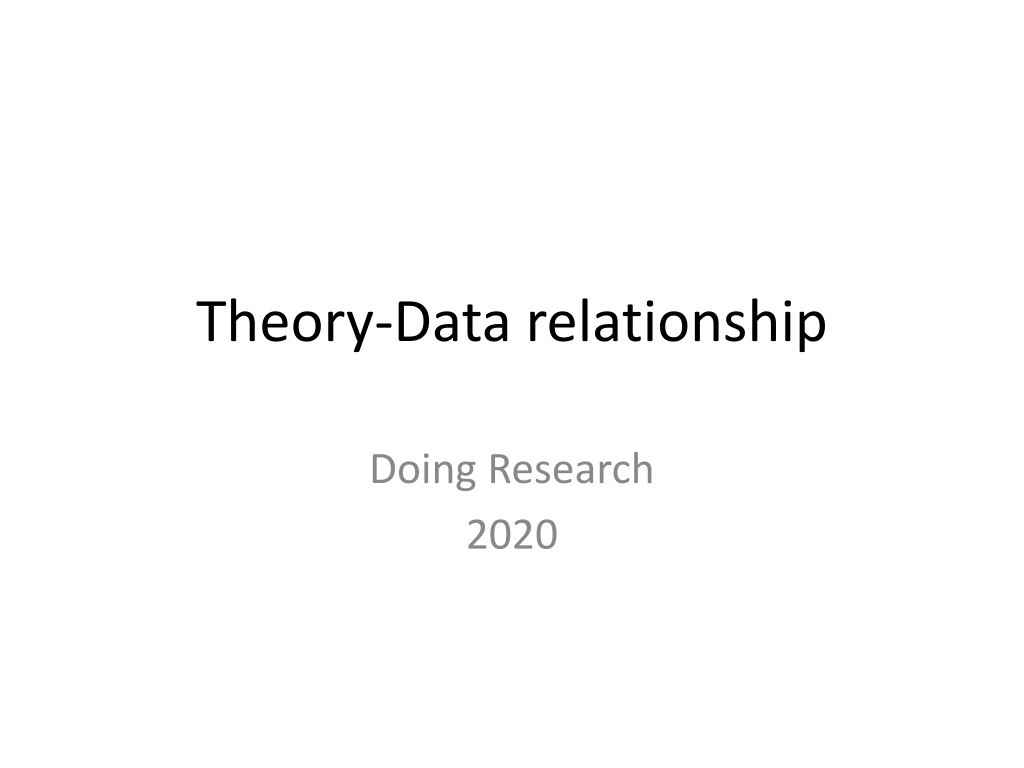



![❤Book⚡[PDF]✔ Doing the Impossible: George E. Mueller and the Management of NASA’](/thumb/21684/book-pdf-doing-the-impossible-george-e-mueller-and-the-management-of-nasa.jpg)


